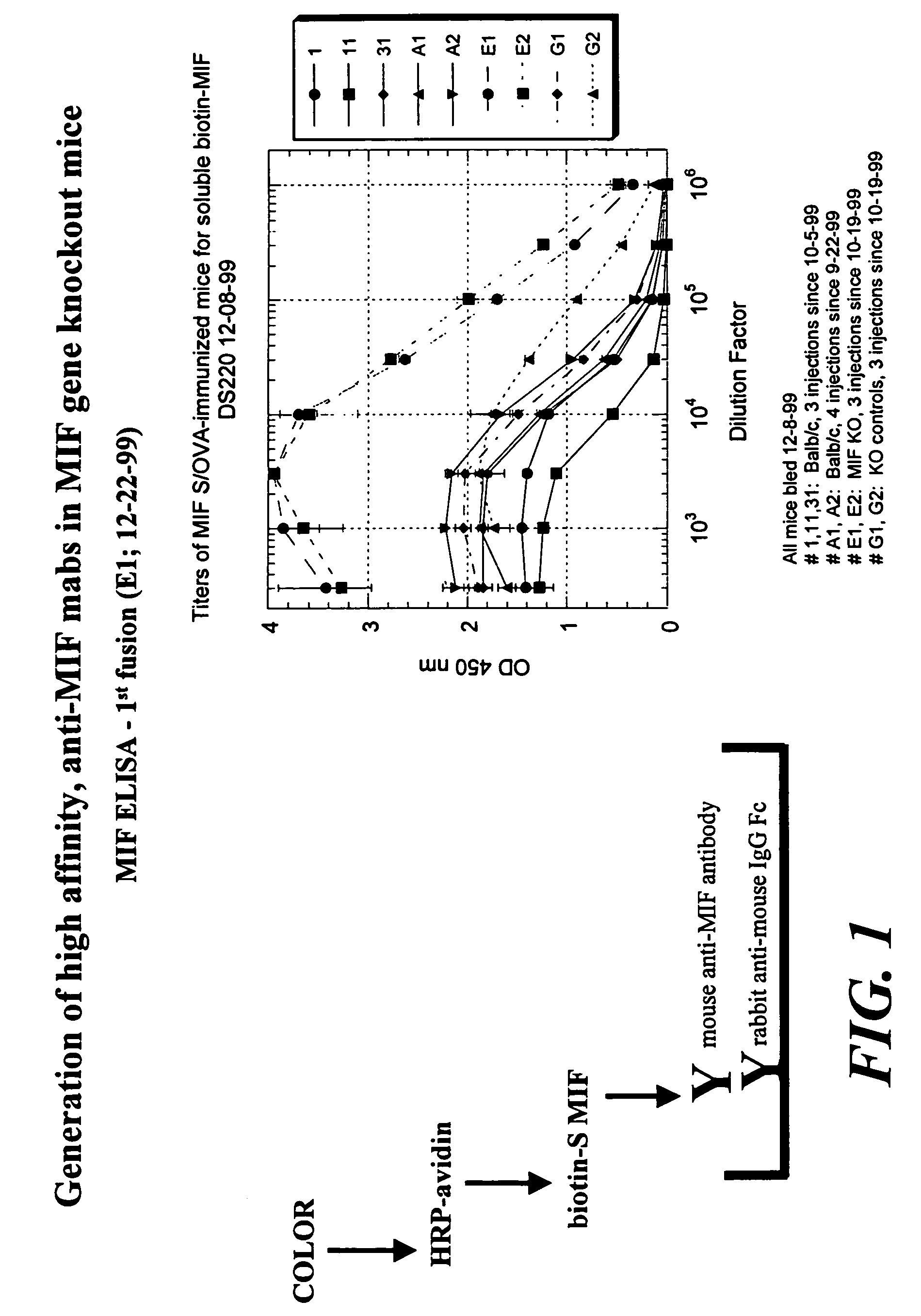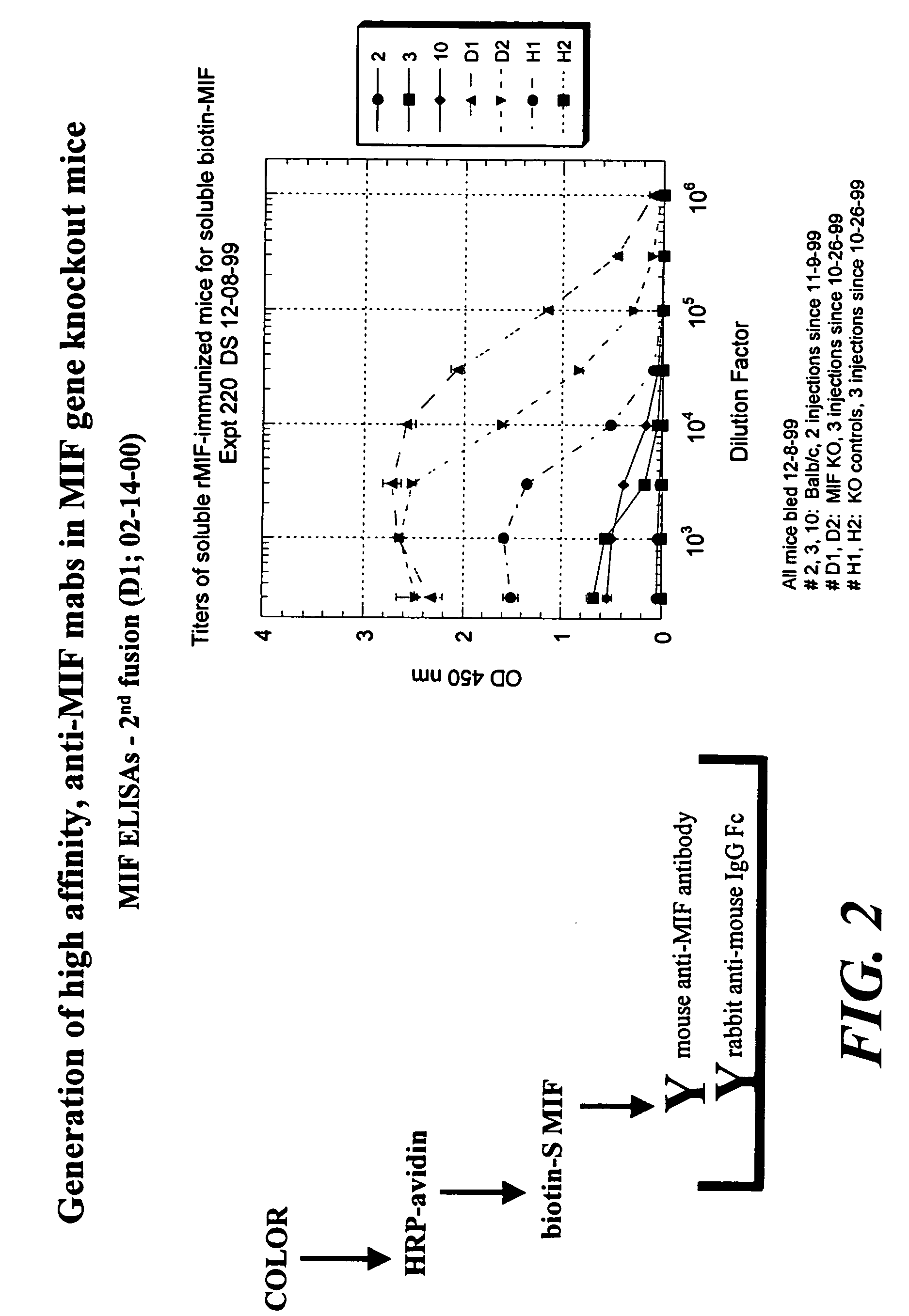Method for preparing anti-MIF antibodies
a technology of mif and antibody, which is applied in the field of preparation of anti-mif antibodies, can solve the problems of difficult production of antibodies against self-antigens or autoantigens such as mif, and antibody production was only in low amounts
- Summary
- Abstract
- Description
- Claims
- Application Information
AI Technical Summary
Benefits of technology
Problems solved by technology
Method used
Image
Examples
example 1
Preparation of a MIF Knock-Out Mouse
[0142]Targeting vector construction and generation of MIF− / − Mice. A mouse MIF genomic fragment is isolated from a 129SV / J genomic library (Bozza et al., Genomics 27: 412-19 (1995)), and a 6.1 kb XbaI fragment containing the 5′ upstream region, exons 1-3, and the 3′ region is subcloned in pBluescript®. The vector is digested with EcoRV (sites present in the 3′ region of the gene and in the polylinker of the plasmid), releasing a 0.7 kb fragment. The vector is religated and digested with AgeI, which disrupts part of exon 2, the second intron, and exon 3. The neo cassette is inserted by blunt ligation after end-filling the vector and the neo cassette. The disrupted genomic vector is digested with XbaI / XhoI and ligated into the HSV-TK vector. The targeting vector is linearized with XhoI, and 30 μg is transfected by electroporation into 107 J1 embryonic stem (ES) cells that are maintained on a feeder layer of neo embryonic fibroblasts in the presence ...
example 2
Preparation of Anti-MIF Antibodies in a MIF Knock Out Mouse
[0144]Six week old mice, which are MIF knock out mice, are immunized by subcutaneous injection of 100 μg of MIF protein, MIF peptides fragment in Freund's Complete Adjuvant on day one, followed by a similar injection in Freund's Incomplete Adjuvant at day 10. Intraperitoneal injections are then performed at weekly intervals of 100 μg of MIF (or a MIF peptide fragment) in phosphate buffered saline (PBS). Blood is collected by supraorbital functions.
example 3
Preparation of Hybridomas
[0145]For hybridoma fusion, the spleen of the mice immunized in Example 2 are isolated and 1×108 splenocytes are fused to an equal number of Ag8 myeloma cells using the standard polyethylene glycol protocol. Selection in hypoxanthine / aminopterine / thymidine is initiated directly after replating the cell suspension into fifteen 96-well flat bottom plates. Supernatants are screened 10-14 days after the hybridoma fusion. Positive hybridomas can then be repeatedly subcloned.
[0146]Analysis of antibody affinity can be assayed by ELISA. For example, one μg of protein / ml PBS is coated in a 96-well polyvinylplate for 3 hours at 37° C. After three washes with PBS / 0.05% Tween-20, the plates are blocked with PBS / 0.1% bovine serum albumin (BSA) for 1 hour at 37° C. Again three washes are performed before the first antibody is incubated. Sera or antibodies are diluted in PBS / 0.05% Tween-20 / 1% fetal calf serum (FCS). The serum incubation is performed for 1 hour at 37° C., f...
PUM
| Property | Measurement | Unit |
|---|---|---|
| equilibrium dissociation constant | aaaaa | aaaaa |
| body weight | aaaaa | aaaaa |
| body weight | aaaaa | aaaaa |
Abstract
Description
Claims
Application Information
 Login to View More
Login to View More - R&D
- Intellectual Property
- Life Sciences
- Materials
- Tech Scout
- Unparalleled Data Quality
- Higher Quality Content
- 60% Fewer Hallucinations
Browse by: Latest US Patents, China's latest patents, Technical Efficacy Thesaurus, Application Domain, Technology Topic, Popular Technical Reports.
© 2025 PatSnap. All rights reserved.Legal|Privacy policy|Modern Slavery Act Transparency Statement|Sitemap|About US| Contact US: help@patsnap.com



